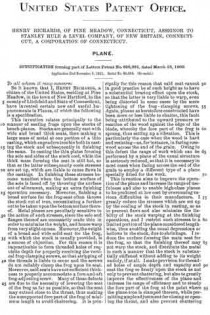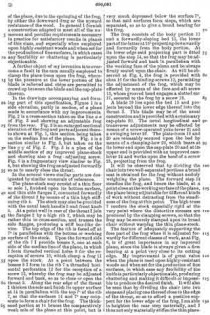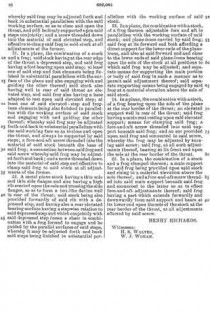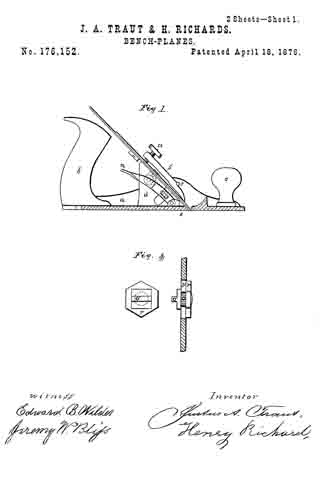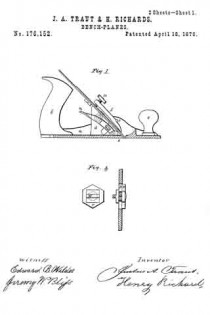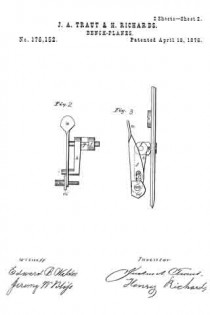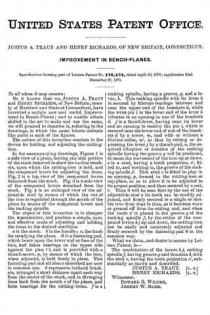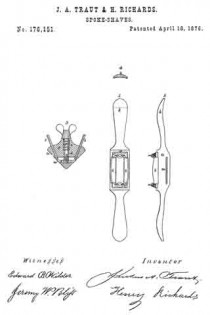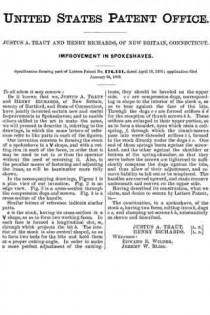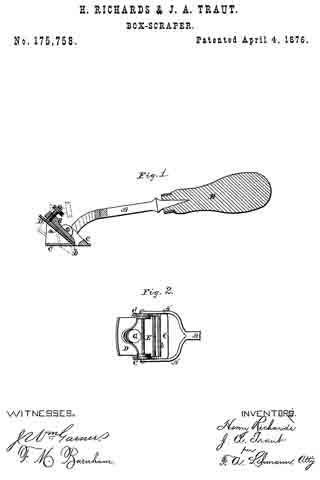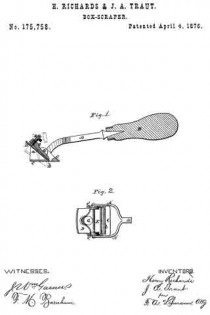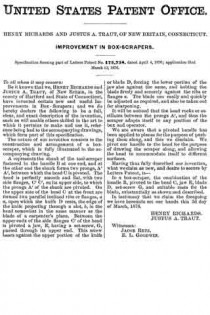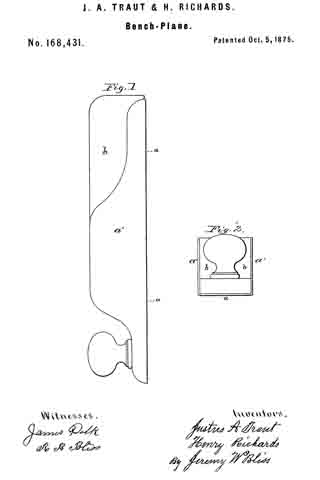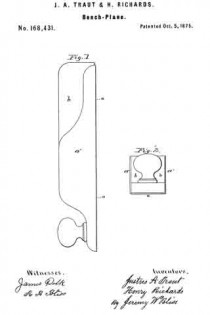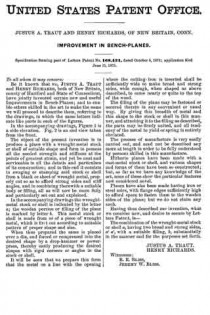No. 696,081 – Plane (Henry Richards) (1902)
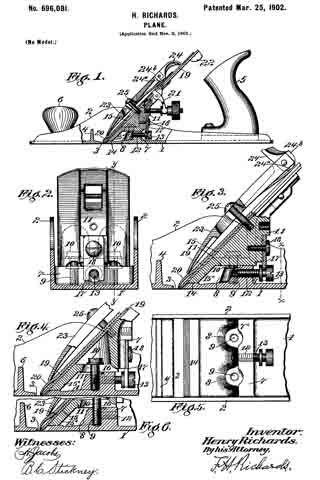
UNITED STATES PATENT OFFICE.
_________________
HENRY RICHARDS, OF PINE MEADOW, CONNECTICUT, ASSIGNOR TO STANLEY RULE & LEVEL COMPANY,
OF NEW BRITAIN, CONNECTICUT, A CORPORATION OF CONNECTICUT.
PLANE.
_________________
SPECIFICATION forming part of Letters Patent No. 696,081, dated March 25, 1902.
Application filed November 2, 1901. Serial No. 80,854. (No model.)
_________________
To all whom it may concern:
Beit known that I, HENRY RICHARDS, a citizen of the United States, residing at Pine Meadow, in the town of New Hartford, in the county of Litchfield and State of Connecticut, have invented certain new and useful Improvements in Planes, of which the following is a specification.
This invention relates principally to the manner of seating frogs upon the stocks of bench-planes. Stocks are generally cast with wide and broad thick seats, thus making a large mass of metal at one portion of a thin casting, which engenders trouble both in casting the stock and subsequently in finishing the same. In casting the thin plates forming the sole and sides of the stock cool, while the thick mass forming the seat is still hot, so that as the latter subsequently cools stresses are set up, which are liable to cause flaws in the castings. In finishing these stresses become manifest when the bottom surface of the sole is faced off by throwing the surface out of alinement, making an extra finishing operation necessary. Moreover, finishing a broad surface for the frog-seat often throws the stock out of true, necessitating a further cut to be taken upon the bottom surface thereof. Metal planes are peculiarly sensitive to the action of such stresses, since the sole and flanges thereof are necessarily made thin in order to minimize the weight, and hence warp from very slight causes. Moreover, the weight of a broad and wide solid seat for the frog, with which the stock is usually provided, is a source of objection. For this reason it is impracticable to form threaded holes of requisite depth for properly receiving the vertical frog-clamping screws, so that stripping of the threads is liable to occur and the screws do not reliably clamp the frog upon its seat. Moreover, said seats have not sufficient thickness to properly accommodate a fore-and-aft frog-adjusting screw. Many of these defects are due to the necessity of lowering the seat of the frog as far as possible, so that the seat may extend close to the throat, thus making the unsupported fore part of the frog of minimum length to avoid chattering. It is principally for this reason that said seat cannot in good practice be of such height as to have a substantial bracing effect upon the stock, so that the latter is very liable to warp, even being distorted in some cases by the mere tightening of the frog-clamping screws. Again, planes as heretofore constructed have been more or less liable to chatter, this fault being-attributed to the upward pressure or reaction of the wood against the edge of the blade, whereby the fore part of the frog is sprung, thus setting up a vibration. This is particularly the case when the wood is hard and resistinge — as, for instance, in facing rose-wood across the end of the grain. Owing to this defect the range of work which can be performed by a plane of the usual structure is seriously reduced, so that it is necessary in most cases when facing across the end of the grain to employ a different type of a plane specially fitted for the work.
This invention aims to improve the operation of the plane and increase its range of usefulness and also to enable high-class planes to be produced at low cost by overcoming various difficulties in their manufacture. I greatly reduce the stresses which are set up by the cooling of the stock in casting, so as to prevent flaws and also minimize the liability of the stock warping at the finishing operations, and I restrict such stresses to a limited portion of the plane considered lengthwise, thus avoiding the usual depressions or hollows in the stock, due to shrinkage. I reduce the surface forming the main seat for the frog, so that the finishing thereof may not warp the stock, and distribute the metal in such a manner that the stock is substantially stiffened without adding to its weight unduly, if at all. I make provision for threaded holes of ample depth and capacity and seat the frog so firmly upon the stock as not only to prevent chattering, but also to greatly improve the effectiveness of the plane and increase its range of efficiency and to steady the fore part of the frog at the point where the plane-iron is clamped thereon, while permitting ample adjustment for closing or opening the throat, and also prevent chattering of the plane, due to the springing of the frog, by either the downward drag or the upward resistance of the wood. In general I furnish a construction adapted to meet all of the numerous and peculiar requirements necessary in practice for satisfactory results in planes of this class, and especially when employed upon highly-resistant woods and when set for the production of fine surfaces, in which cases any flexibility or chattering is particularly objectionable.
A further object of my invention is to overcome a fault in the cam usually employed to clamp the plane-irons upon the frog, whereby the pressure at the lower portion of the blade is relieved and chips are permitted to crowd up between the blade and the cap-plate thereon.
In the drawings accompanying and forming part of this specification, Figure 1 is a side elevation, partly in section, of a plane made in accordance with my improvements. Fig. 2 is a cross-section taken on the line x x of Fig. 3 and showing an adjustable frog from the rear. Fig. 3 is an enlarged sectional elevation of the frog and parts adjacent thereto shown at Fig. 1, this section being taken on the median line of the plane. Fig. 4 is a section similar to Fig. 3, but taken on the line y y of Fig. 2. Fig. 5 is a plan of the middle section of my improved plane-stock and showing also a frog-adjusting screw. Fig. 6 is a fragmentary view similar to Fig. 4, but showing the frog as adjusted forwardly so as to nearly close the throat.
In the several views similar parts are designated by similar numerals of reference.
The plane-stock may consist of a thin floor or sole 1, finished upon its bottom surface, and thin side flanges 2, connected forwardly of the throat 3 by means of a thin high stiffening-rib 4. The stock may also be provided with the usual back handle 5 and front knob 6. At a point well in rear of the throat I join the flanges 2 by a high rib 7, which may be rather thin in cross-section, and trusses the side flanges, producing a stilf box-like device. The top edge of the rib is faced off at 7a in parallelism with the bottom or working surface of the stock. Upon the forward side of the rib 7 I provide bosses 8, one at each side of the median line of the plane, in which I form threaded vertical holes 9 for the reception of screws 10, which clamp a frog 11 upon the stock. At a point between the bosses 8 I form in the rib 7 a threaded horizontal perforation 12 for the reception of a screw 13, whereby the frog may be adjusted forward and back, so as to close or open the throat 3. Along the rear edge of the throat I thicken the sole and finish its upper surface at 14 in parallelism with the top 7a of the rib 7, so that the surfaces 14 and 7a may cooperate to form a chair for the frog. The thickened portion at 14 braces the comparatively weak sole of the plane at this point, but is very much depressed below the surface 7a, so that said surfaces form steps, which are separated, so as to give a broad bearing for the frog.
The frog consists of the body portion 11 and a forwardly-sloping bed 15, the lower part of the latter at 15a projecting downwardly and forwardly from the body portion. At its lower edge said projecting part is fitted upon the step 14, so that the frog may be adjusted forward and back in parallelism with the working face of the plane and be always firmly seated upon the chair. As will be observed at Fig. 4, the frog is provided with slots 16 for the binding-screws 10, permitting the adjustment of the frog, which may be effected by means of the fore-and-aft screw 13, whose grooved head engages a slotted ear 17, secured to the frog by a screw 18.
A blade 19 lies upon the bed 15 and projects beyond the lower edge thereof into the throat 3. This blade may be of the usual construction and is provided with a customary cap-plate 20. The usual longitudinal and transverse adjustments may be effected by means of a screw-operated yoke-lever 21 and a swinging lever 22. The plate-irons 10 and 20 are releasably secured upon the bed by means of a clamping-bow 23, which bears at its lower end upon the cap-plate 20 and at its upper end is provided with an improved cam-lever 24 and works upon the head of a screw 25, projecting from the frog.
It will be observed that by dividing the chair into two well-separated portions abroad seat is obtained for the frog without unduly weighting the plane. The forward step 14 steadies the frog, and hence the blade, at a point close at the working surface of the plane, the plane being adjustable for different kinds of work without detracting from the steadiness of the frog at this point. The high truss 7 renders the stock especially rigid at the very point where the distortive stresses are produced by the clamping-screws, so that the frog may be securely clamped upon its broad chair without warping the thin plane-stock.
The feature of adequately supporting the fore part of the frog when it is adjusted forwardly for different classes of work, as at Fig. 6, is of great importance in my improved plane, since the blade is always given a firm bearing at a point very close to its cutting edge. My improvement is of great value when the plane is used upon highly-resistant woods and when set for the production of line surfaces, in which case any flexibility of the knife is particularly objectionable, producing chattering and making it difiicult or impossible to produce the desired finish. It will also be seen that by dividing the chair into two steps and placing one thereof close to the edge of the throat, so as to afford a positive support for the lower edge of the frog, I am able to heighten the rear step materially, and I thus not only materially stiffen the thin plane-stock, but apply the stiffening-truss at the very portion which is subjected to the most stress. Moreover, I am enabled to increase the depth of the holes for the clamping-screws and also to make ample provision for a fore-and-aft adjusiing-screw and all without adding materially to the weight, but instead reducing the objectionable thickness of metal usual in stock of this kind.
A further and important feature of my improvements appertains to the means illustrated for putting the fore part or nose of the frog normally under tension, whereby I am enabled to secure a perfect action of the plane. As will be observed at Fig. 4, the clamping-screws 10 bear upon the frog at a point between the two steps of the chair, thereby not only clamping the body of the frog securely upon the rear step, but also tending to flex the fore part of the frog and holding it down upon the seat 14 with considerable pressure. Owing to this normal tension upon the frog, it results that applying pressure to or removing it from the blade when planing operates in a far less degree than heretofore to spring the frog. It will be understood that when a frog is held upon a broad single seat by means of screws located in the usual manner this normal stress or tension of the frog is wanting, and the fore part of the frog consequently is left somewhat flexible, so that the pressure of the wood upward under the point of the blade springs up both the blade and the frog and permits a vibration which in many cases amounts to a chattering of the edge of the blade upon the wood. Thus it will be seen that I not only provide a positive support at all times for the fore part of the frog, but also that I spring said fore part upon said support, so that the blade is prevented from chattering either by the downward pull or by the upward thrust of the wood. I thus widen the range of work for which this type of plane is adapted and secure a more reliable operation and better results generally on all kinds of work.
Owing to the proximity of the clamping-screws to the rear-step 7a and their remoteness from the forward step 14, the pressure upon the frog is distributed between the two steps in substantial correspondence to the relative abilities of the two portions of the thin stock to sustain the pressure, without warping or distortion, so that the frog is thus put into condition to avoid chattering without incurring a liability of distorting the stock.
The cam-lever 24 is formed with a curved working surface 24a, which as the lever is turned gradually forces the bow against the plane-irons, said surface 24a terminating in a tangential stop-surface 24b, which arrests the lever just as the point of greatest compression is reached, so that there is no possibility of a reactional movement of the plane-irons, as is usually the case, and the latter are held under maximum tension, thus im-
proving their action and avoiding the liability of chips working between the irons.
Not the least of the several valuable features of my invention consists in the provision for adjustment of the frog forth and back in substantial parallelism with the nnished bottom or working surface of the stock and at the same time enabling said frog however adjusted to be firmly supported not only at its main or body portion, but also at its front end. At least one and preferably both of the elements 15a and 14 are finished in substantial parallelism with the working surface of the stock, and the same is true of the elements 7 and 11. In the construction illustrated a parallelism of adjustment is secured through a parallelism of bearing-surfaces with the working or bottom face of the stock, one of said parallel bearing-surfaces being in front and being formed or provided upon either the frog or the stock, and another of said parallel bearing-surfaces being in rear and also formed or provided upon either the frog or the stock, the surfaces contacting with said parallel bearing-surfaces being themselves preferably also parallel with said working face of the stock, thereby giving considerable breadth or area of contact at both the fore and aft portions of the frog, which is desirable. It will be understood that by having at least one such parallel bearing-surface in front and at the lower portion of the plane and at least one more such parallel bearing-surface in rear and at a considerable elevation it becomes practicable both to adjust the frog forth and back and also to support the same firmly both fore and aft at all such adjustments. I consider it of especial value that the portion 7 of the stock has a stepwise arrangement relatively to the bearing-surface at the throat in said stock, since thereby it becomes practicable in this class of planes to effect a parallel adjustment of the frog while always firmly supporting not only the body but also the fore foot of the latter, this fore foot being an exceedingly sensitive part of the plane and the true action thereof being of the utmost importance. It will be observed that the frog at its forward end affords a direct support for the lower ends of the plane-irons and also at said end and close to the lower ends of said plane-irons bears directly upon the sole of the stock at all times. By maintaining the frog constantly at the same vertical distance from the working-surface or floor of the stock the throat may be closed or opened to any extent by a simple and rapid manipulation without the necessity of resetting the plane-irons either in longitudinal direction or transversely by means of the lever 22, while at all times the action of the plane is rendered most satisfactory. In this instance the adjustment of the frog is effected by means of a fore-and-aft screw threaded into the material of the stock beneath the base of the frog and connected to the latter.
Variations may be resorted to within the scope of my invention, and portions of my improvements may be used without others.
Having described my invention, I claim —
1. A metallic plane-stock having a thin sole and thin side flanges, and also having at the rear edge of the throat a depressed step, and well in rear thereof an elevated step; the upper surfaces of said steps being finished parallel with each other and substantially parallel with the working surface of the stock, so as to form a chair for a frog; and said elevated step being in the form of a high rib erected upon the sole and trussing the side flanges, so as to form a box-like device.
2. A metallic plane-stock having a thin sole and thin side flanges, and also having at the rear edge of the throat a depressed step, and well in rear thereof an elevated step; said depressed step being in the form of a slight thickening of the edge of the sole along the rear side of the throat, and said elevated step being in the form of a high rib erected upon the sole and trussing the side flanges, so as to form a box-like device; the upper surfaces of said steps being linished parallel with each other and substantially parallel with the working surface of the stock, so as to form a chair for a frog.
3. A metallic plane-stock having a high step which is provided with a deep threaded hole for receiving a frog-clamping screw; said stock also having at the rear edge of the throat and forward of said high step a depressed step; and said steps being finished in parallelism with the working surface of the stock and cooperatively adapted to form a chair for a frog.
4. A metallic plane-stock having a thin sole and thin side flanges, and also having well in rear of the throat a thin high transverse rib which trusses said flanges and also forms a rear step, said rib being provided with two deep holes for receiving frog-clamping devices, one hole at each side of the stock; said stock also having at the rear edge of the throat a depressed forward step which is formed by thickening the throat edge of the sole; said step being cooperatively adapted to form a chair for a frog, and each thereof being finished parallel with the working surface of the stock.
5. A metallic plane-stock having a rear step provided at its front side with a threaded hole for receiving a frog-clamping screw; and also having at the rear edge of the throat and forward of said threaded hole a depressed step; said steps being finished in parallelism with the working surface of the stock and cooperatively adapted to form a chair for a frog.
6. A metallic plane-stock having a sole and side flanges and also having well in rear of the throat a narrow high transverse rib which trusses the flanges and also forms a rear step; said step having at its forward side two threaded holes, one at each side of the median line of the stock, for receiving frog-clamping screws; said sole also having at the rear edge of the throat, a thickening which forms a depressed forward step; said steps being finished in parallelism and cooperatively adapted to form a chair for a frog.
7. A metallic plane-stock having a sole and side flanges, and also having well in rear of the throat a narrow high transverse rib which trusses said flanges and also forms a rear step; said rib having a fore-and-aft threaded perforation for receiving a long frog-adjusting screw, which may project forwardly through said rib; and also having an upfand-down threaded hole for receiving a frog-clamping screw; said stock also having at the rear edge of the throat a depressed forward step; said steps being cooperatively adapted to form a chair for a frog, and being finished parallel with the working surface of the stock.
8. A metallic plane-stock having a sole and side flanges and also having well in rear of the throat a narrow high transverse rib which trusses said flanges and also forms a rear step; said rib having a fore-and-aft threaded perforation for receiving a long frog-adjusting screw, which may project forwardly through said rib; and said sole also having at the rear edge of the throat a depressed forward step; said steps being finished in parallelism and being substantially parallel with the working surface of the stock, and being cooperatively adapted to form a chair for a frog.
9. A metallic plane-stock having a sole and side flanges and also having well in rear of the throat a narrow high transverse rib which trusses said flanges and also forms a rear step; said rib having a fore-and-aft threaded perforation for receiving a frog-adjusting screw, and also having at its front side two vertical threaded holes, one upon each side of said perforation, for receiving frog-clamping screws; said sole being also thickened at the rear edge of the throat so as to form a depressed forward step; said steps being finished in parallelism and substantially parallel with the working surface of the stock, and being cooperatively adapted to form a chair for a frog.
10. A metallic plane-stock having well in rear of the throat a pair of vertically bored and threaded bosses formed upon the front side of a rear step; said stock also having at the rear edge of said throat and forward of said bosses a thickening which forms a depressed forward step; and said steps being finished in parallelism with the working surface of the stock and cooperatively adapted to form a chair for a frog.
11. A metallic plane-stock having a sole and side flanges and also having well in rear of the throat a pair of vertically-bored bosses formed upon the front side of a narrow high transverse rib that trusses said flanges, and also forms a rear step; said stock also having at the rear of said throat a depressed forward step; said steps being cooperatively adapted to form a chair for a frog; and said rib being also provided between said bosses with a fore-and-aft threaded perforation for receiving a frog-adjusting device.
12. In a plane, the combination of a stock and a frog; the stock having a thin sole and thin side flanges, and also having at the rear edge of the throata depressed step, and wellin rear thereof an elevated step; the upper surfaces of said steps being finished parallel with each other and substantially parallel with the working surface of the stock; said elevated step being in the form of a high rib erected upon the sole and trussing the side flanges, so as to form a box-like device; and said frog being fitted to and adjustably secured upon said steps.
13. In a plane, the combination of a stock and a frog; the stock having a sole and side flanges, and also having well in rear of the throat a narrow high transverse rib which trusses said flanges and also forms a rear step; said stock also having at the rear edge of the throat a depressed forward step; and said frog being fitted upon said steps and secured thereto by one or more screws which pass down into deep holes formed in said truss, and being also connected to a fore-and-aft screw which engages a threaded perforation also formed in said truss.
14. In a plane, the combination with a stock having a chair consisting of separated seats, of a frog fastened upon said chair by means of a device which bears upon the frog at a point between said seats and thereby causes the frog to bear upon both seats.
15. In a plane, the combination with a stock; having a chair consisting of separated seats, of a frog fastened upon said chair by means of a device which bears upon the frog at a point between said seats but close to one thereof, so as to cause the frog to bear unequally upon the seats.
16. In a plane, the combination with a stock, of a frog fastened thereon and capable of fore-and-aft adjustment; said stock having a sole and side flanges, and having at the rear edge of the throat a depressed step, and well in rear of the throat a narrow high transverse rib which trusses said flanges and also forms a rear step; and said frog being fastened by one or more screws placed at the forward side of said rear step, and bearing upon the frog between its fore~and-aft supports, so that the frog is rigidly seated upon the rear step and is also caused to bear firmly upon the front step at all such adjustments of said frog.
17. In a plane, the combination of a stock and a frog; the stock having a thin sole and thin side flanges, and also having at the rear edge of the throat a depressed step, and well in rear thereof an elevated step; the upper surfaces of said steps being finished parallel with each other and substantially parallel with the working surface of the stock; said elevated step being in the form of a high rib erected upon the sole and trussing the side flanges, so as to form a box-like device; and said frog being fitted to and adjustably secured upon said steps; plane-irons; a clamping-bow; and a cam-lever formed with a curved working surface 24a, which as the lever is turned gradually forces the bow against the plane-irons, said surface 24a terminating in a tangential stop-surface 24b, which arrests the lever just as the point of greatest compression is reached.
18. In a plane, the combination of a stock and a frog; said stock having at the rear border of the throat a depressed step, and said frog having a foot bearing upon said step; at least one of said step and foot elements being finished in substantial parallelism with the working surface of the stock and also engaging with and guiding the other thereof;
said stock also having well in rear of said throat an elevated step, and said frog also having a base adapted to rest upon said elevated step; and at least one of said elevated-step and frog-base elements being also finished in parallelism with the working surface of said stock and engaging with and guiding the other thereof; whereby said frog may be adjusted forth and back in substantial parallelism with the said working surface, so as to close and open the throat, and be always conjointly supported by said steps.
19. In a plane, the combination of a stock and a frog; said stock having at the rear border of the throat a depressed step, and said frog having a foot bearing upon said step; at least one of said step and foot elements being finished in substantial parallelism with the surface of the plane and also engaging with and guiding the other thereof; said stock also having well in rear of said throat an elevated step, and said frog also having a base adapted to rest upon said elevated step; and at least one of said elevated-step and frog-base elements being also finished in parallelism with the working surface of said stock and engaging with and guiding the other thereof; whereby said frog may be adjusted forth and back in substantial parallelism with the said working surface so as to close and open the throat, and be always conjointly supported by said steps; a fore-and-aft screw threaded into the material of said stock beneath the base of said frog; and a connection between said frog and said screw; whereby said frog may be adjusted forth and back.
20. In a plane, the combination of a stock and a frog; said stock having at the rear border of the throat a depressed step, and said frog having a foot bearing upon said step; at least one of said step and foot elements being finished in substantial parallelism with the surface of the plane and also engaging with and guiding the other thereof; said stock also having well in rear of said throat an elevated step, and said frog also having a base adapted to rest upon said elevated step; at least one of said elevated-step and frog-base elements being also finished in parallelism with the working surface of said stock and engaging with and guiding the other thereof; whereby said frog may be adjusted forth and back in substantial parallelism with the said working surface, so as to close and open the throat, and still be firmly supported upon said steps conjointly; and a screw threaded down into the material of said elevated step, and effective to clamp said frog to said stock at all adjustments of the former.
21. In a plane, the combination of a stock and a frog; said stock having at the rear edge of the throat a depressed step, and said frog having a foot bearing upon said step; at least one of said step and foot elements being finished in substantial parallelism with the surface of the plane and also engaging with and guiding the other thereof; said stock also having well in rear of said throat an elevated step, and said frog also having a base adapted to rest upon said elevated step; at least one of said elevated-step and frog-base elements being also finished in parallelism with the working surface of said stock and engaging with and guiding the other thereof; whereby said frog may be adjusted forth and back in substantial parallelism with the said working face so as to close and open the throat, and always be supported by said steps; a fore-and-aft screw threaded into the material of said stock beneath the base of said frog; a connection between said frog and said screw whereby said frog may be adjusted forth and back; and a screw threaded down into the material of said step and effective to clamp said frog to said stock at all adjustments of the former.
22. A metal plane-stock having a thin sole and thin side flanges and also having a high rib erected upon the sole and trussing the side flanges, so as to form a box-like device well in rear of the throat; said stock being also provided forwardly of said rib with a depressed step, and having also a rear elevated bearing-surface having a stepwise relation to said depressed step and which con jointly with said depressed step forms a chair in combination with a frog formed to engage and be guided by the parallel surfaces of said steps, whereby it may be adjusted forth and back said steps being finished in substantial parallelism with the working surface of said stock.
23. In a plane, the combination with a stock, of a frog thereon adjustable fore and aft in parallelism with the working surface of said stock; and plane-irons carried by said frog; said frog at its forward end both affording a direct support for the lower ends of the plane-irons, and also at said forward end and close to the lower ends of said plane-irons bearing upon the sole of the stock at all positions to which said frog may be adjusted; and separate means for supporting the main portion or body of said frog in such a manner as to permit said adjustment thereof; said separate supporting means being engaged by said frog at a material elevation above the sole of said stock.
24. In a plane, the combination with a stock, of a frog bearing upon the sole of the plane at the rear border of the throat; an elevated support well in rear of the throat; said frog having a main seat resting upon said elevated support; means for clamping said frog; a fore-and-aft screw threaded into said support beneath said frog; and an ear provided upon said frog and connected to said screw, whereby the frog may be adjusted by turning said screw; said frog, at all such adjustments thereof, bearing at its front end upon the sole at the rear border of the throat.
25. In a plane, the combination of a stock and a frog clamped thereon; a main support for said frog being provided upon said stock and rising to a material elevation above the sole thereof; and afore-and-aft screw threaded into said main support beneath said frog and connected to the latter so as to effect fore-and-aft adjustments thereof; said frog having a part which extends forwardly and downwardly from said support and bears at its lower end upon the sole of the stock at the rear border of the throat, at all adjustments effected by said screw.
HENRY RICHARDS.
Witnesses:
H. S. WALTER,
W. J. WORAM.


